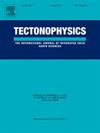巴西赤道边缘的地球物理构造格架与构造演化
IF 2.7
3区 地球科学
Q2 GEOCHEMISTRY & GEOPHYSICS
引用次数: 0
摘要
巴西赤道边缘(BEM)包括一个西西北向至西北向的段,沿此段发育了从新巴雷米亚到阿尔比安的一套复杂的沉积盆地。最近在非洲加纳和南美洲圭亚那/苏里南的大陆边缘发现了碳氢化合物储量,这提高了人们对赤道大西洋边缘研究的兴趣。在这种情况下,更好地了解这些盆地形成的机制至关重要,这些盆地的勘探潜力仍然是开放的。大多数关于边界元法的研究要么集中在小区域,而没有将结果与非洲的研究结果进行比较,要么涉及忽略超伸展地壳剖面的区域重建,从而阻碍了更准确的拟合。这项工作的目的是根据来自不同来源、类型和分辨率的重力、磁和多通道二维地震数据的合并,定义边界元的深部地壳结构,并描绘从大陆地壳到严格意义上的海洋地壳的过渡。根据Manatschal(2004)、Osmundsen和psamons - pinvidic(2018)、psamons - pinvidic等人(2013,2015)提出的分类方案和模型,我们的研究结果使我们能够将BEM分为四个域:近端域(PD)、颈颈区(NZ)、远端域(DD)和大洋域(OD)。这些区域以阿普天—阿贝边NW-SE正滑断层和斜滑断层为主,以及NE-SW褶皱和逆冲断层为主,均与东西向走滑或斜滑断层有关。远端域的性质可以从渐变到突变,这取决于它的位置和每个边缘段的主导构造样式。与其他研究报道的情况不同,DD的向海边界以与现今海洋断裂带正交的大陆-海洋边界(COB)为标志。我们确定的边界确保了在塞诺曼尼亚时期,BEM大陆地壳与非洲赤道边缘(AEM)之间的良好契合。本文章由计算机程序翻译,如有差异,请以英文原文为准。
Geophysically-BASED structural framework and tectonic evolution of the Brazilian equatorial margin
The Brazilian Equatorial Margin (BEM) encompasses a WNW to NW-trending segment along which a complex set of sedimentary basins were developed from the Neobarremian to the Albian. Recent discoveries of hydrocarbon reserves in the continental margins of Ghana, in Africa, and Guyanas/Suriname, in South America, have heightened interest in studying the Equatorial Atlantic margins. In this context, it is crucial to understand better the mechanisms that led to the formation of these basins, whose exploratory potential is still open. Most studies on the BEM either focus on small areas without comparing results to their African counterparts or involve regional reconstructions that overlook hyperextended crustal sections, thus hindering a more accurate fit. This work aims to define the deep crustal architecture of the BEM and delineate the transition from continental to strictly oceanic crust based on the merging of gravimetric, magnetic, and multichannel 2D seismic data from various sources, types, and resolutions. Our findings have allowed us to categorize the BEM into four domains, according to classification schemes and models proposed by Manatschal (2004), Osmundsen and Péron-Pinvidic (2018), Péron-Pinvidic et al. (2013, 2015): proximal (PD), necking zone (NZ), distal domain (DD), and oceanic domain (OD). These domains feature a predominance of Aptian to Albian NW-SE normal and oblique-slip faults, as well as NE-SW folds and thrusts, all of which are associated with E-W strike-slip or oblique-slip faults. The nature of the distal domain zone can vary from gradual to abrupt, depending on its location and the dominant structural style in each margin segment. The oceanward limit of the DD is marked by a continent-ocean boundary (COB) that runs orthogonal to the present-day oceanic fracture zones, unlike what has been reported in other studies. Our defined boundaries ensured a good fit between the continental crusts of the BEM and the African Equatorial Margin (AEM) during the Cenomanian period.
求助全文
通过发布文献求助,成功后即可免费获取论文全文。
去求助
来源期刊

Tectonophysics
地学-地球化学与地球物理
CiteScore
4.90
自引率
6.90%
发文量
300
审稿时长
6 months
期刊介绍:
The prime focus of Tectonophysics will be high-impact original research and reviews in the fields of kinematics, structure, composition, and dynamics of the solid arth at all scales. Tectonophysics particularly encourages submission of papers based on the integration of a multitude of geophysical, geological, geochemical, geodynamic, and geotectonic methods
 求助内容:
求助内容: 应助结果提醒方式:
应助结果提醒方式:


